Red Panda
Ailurus fulgens
There are less than 3,000 left in the wild!
Advertisement
Red Panda Scientific Classification
- Kingdom
- Animalia
- Phylum
- Chordata
- Class
- Mammalia
- Order
- Carnivora
- Family
- Ailuridae
- Genus
- Ailurus
- Scientific Name
- Ailurus fulgens
Read our Complete Guide to Classification of Animals.
Red Panda Conservation Status
Red Panda Facts
- Prey
- Bamboo, Berries, Eggs
- Name Of Young
- Cub
- Group Behavior
- Solitary
- Fun Fact
- There are less than 3,000 left in the wild!
- Estimated Population Size
- less than 3,000
- Biggest Threat
- Habitat loss
- Most Distinctive Feature
- Rusty coloured thick fur and striped face
- Other Name(s)
- Lesser Panda, Fire Fox
- Gestation Period
- 4 months
- Habitat
- High-altitude mountain forest
- Predators
- Snow Leopard, Marten, Human
- Diet
- Omnivore
- Average Litter Size
- 3
- Lifestyle
- Nocturnal
- Common Name
- Red Panda
- Number Of Species
- 1
- Location
- Himalayas
- Slogan
- There are less than 3,000 left in the wild!
- Group
- Mammal
Red Panda Physical Characteristics
- Color
- Brown
- Red
- White
- Skin Type
- Fur
- Top Speed
- 24 mph
- Lifespan
- 8 - 12 years
- Weight
- 3kg - 6.2kg (7lbs - 14lbs)
- Length
- 60cm - 120cm (24in - 47in)
- Age of Sexual Maturity
- 18 months
- Age of Weaning
- 5 months
View all of the Red Panda images!
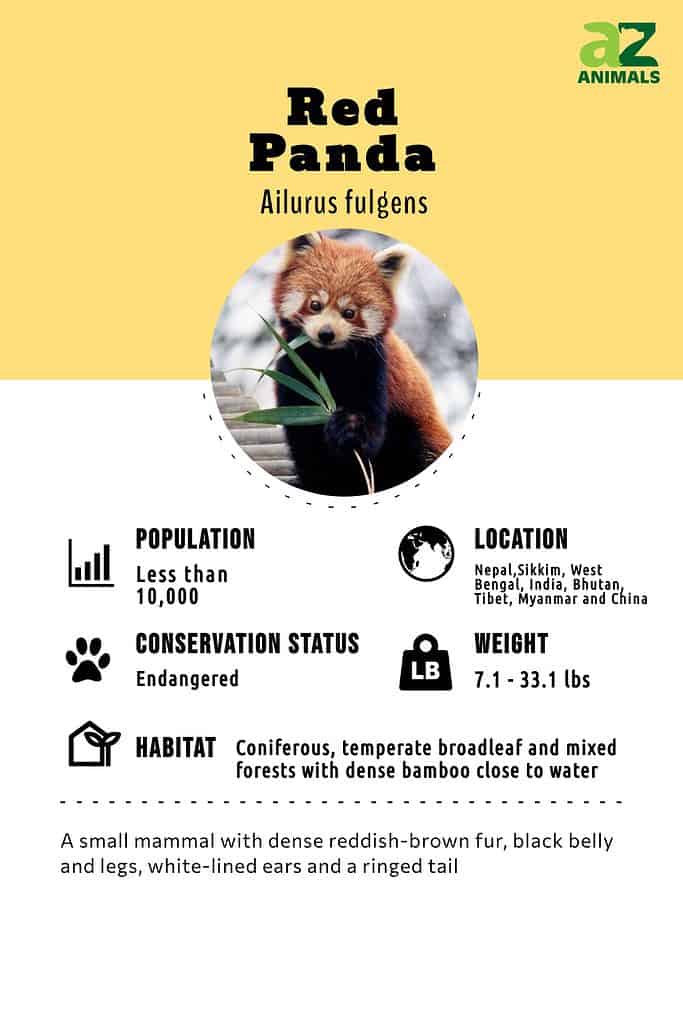
Classification and Evolution
The red panda (Ailurus fulgens) is a cat-sized species of carnivorous mammal that is found inhabiting the temperate mountain forests on the slopes of the Himalayas. Ailuridae is a family in the mammal order Carnivora, of which the red panda is the only living representative. As their name suggests, they are quite distantly related to the larger and more famous giant panda. The extinct Himalayan and Chinese red pandas diverged from their bear ancestors 250,000 million years ago. The red panda shares a peculiar trait with the giant panda with both animals having elongated wrist bones – or false thumbs- for grasping bamboo. However, molecular testing has shown the red panda to be more closely related to raccoons, weasels, and skunks. The red panda is also known by a number of different names in their native regions including the lesser panda, the red cat-bear, and the firefox in Nepal. Like their much larger distant cousin, the red panda is an animal that relies on bamboo for nutrition and with rapid deforestation of these unique areas, there is less and less for these animals to eat, which has ultimately led to the red panda being listed as being an endangered species.
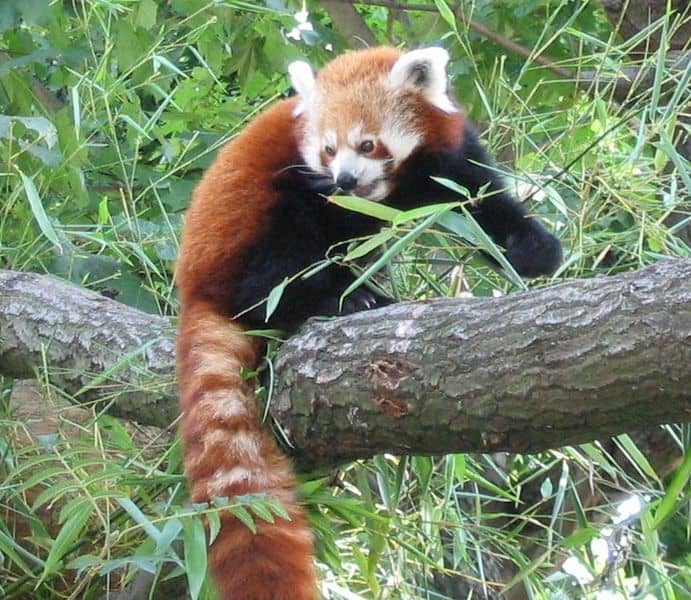
Red Pandas resemble raccoons more than bears.
Anatomy and Appearance
The red panda is an endearing animal that is about the same size as a large housecat, with a cat-like face and a long, bushy tail. Their bodies are covered with a thick reddish fur except for their almost white-colored ears, cheeks, muzzle, and spots above their eyes. The red panda also has reddish-brown stripes that run down either side of its white muzzle, along with alternating light and dark rings on its tails. The red panda is equipped with semi-retractable claws to aid stability while climbing on trees and branches. They also have strong, tough jaws which they use to chew on bamboo. Like the giant panda, the red panda also has a unique extended wrist bone that operates like something similar to a human thumb, allowing them to hold onto bamboo while they are chewing it. Thick, tightly packed fur helps to keep red pandas warm during the cold winters they face in their habitat. The red panda also sports extra thick fur on the soles of their feet for warmth and traction.
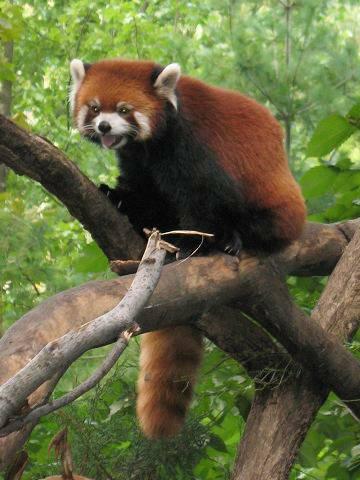
Red Pandas are being pushed out of their native habitats.
Distribution and Habitat
The red panda inhabits the temperate forests in the Himalayas at altitudes between 1,800 and 4,000 meters. These high mountain slopes are typically covered in deciduous hardwood forests with a bamboo that is crucial to the red panda’s survival, growing beneath the forest’s canopy. Their historical range extended through Bhutan, Nepal, India, Myanmar, and China, where their range often overlapped that of the even rarer giant panda, Now, however, the red panda is extinct in certain of these areas and its numbers are rapidly declining in others. Due to the fragile ecology of their native, mountain forests and their reliance on a diet largely consisting of bamboo, the red panda is being pushed into smaller and more isolated pockets within their once wide range. Climate change is affecting the ability of these habitats to produce adequate bamboo to sustain the species.

Red pandas spend their days sleeping and nights eating.
©dean bertoncelj/Shutterstock.com
Behavior and Lifestyle
The red panda is generally a nocturnal and solitary animal, with the exception of breeding season. Red pandas spend the daylight hours sleeping in branches high in the tree canopy with their long, bushy tail wrapped around them to keep them warm. Although they are known to feed in the trees, they usually come down to the ground after dusk to begin foraging in the safety of the darkness. The red panda is a territorial animal that marks its path with droppings and urine, and releases a musky secretion from its anal glands. They often communicate with one another using short whistles and squeaks. The red panda is a strong and agile climber, and while it normally sleeps safely in the branches during the day, it can also dart up a trunk, using its sharp claws, if threatened by predators .
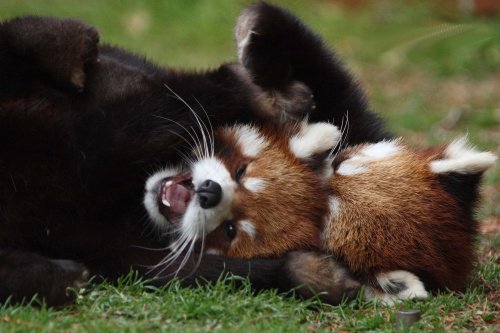
Red panda cubs may not leave the nest until they are three months old.
Reproduction and Life Cycles
Red pandas usually breed between January and March. After a gestation period that lasts for around four months, the female gives birth to 1 – 5 cubs. The cubs are born blind, and although they begin to open their eyes within a couple of weeks, the eyes of the red panda cubs don’t fully open until they are about a month old. Before her cubs are born, the female red panda builds a nest in a hollow area in a tree, among roots, or in a bamboo thicket lined with leaves, moss, and other soft plant material. Red panda cubs typically do not leave the nest until they are around three months old and are strong enough to negotiate the tricky branches. They feed solely on bamboo until they are old enough to stomach other foods. Red pandas reach their full adult size after about a year. There is a high mortality rate in young red pandas, with up to 80% never reaching full adulthood.

Red pandas are classified as carnivorous but their diet is mostly bamboo shoots.
©Jose Angel Astor Rocha/Shutterstock.com
Diet and Prey
Although the red panda belongs to a carnivorous group of mammals, their diet is in fact almost entrirely vegetarian, as bamboo shoots comprise the majority of their diet. However, as the red panda is a mammal it has a short digestive system, meaning that while bamboo holds little nutrition in any event, red pandas cannot get the most out of their meals. Unlike the giant panda though, however, the red panda will also eat a variety of other foods to supplement its diet. These foods include acorns, berries, and grasses, along with grubs, mice, lizards, chicks, and birds’ eggs. Red pandas have excellent sight, smell, and hearing. In addition, the red panda also has long, white whiskers on its snout which help it to navigate through the dense vegetation in the darkness of night, when it most actively forages for food. For a complete list of foods red pandas eat, check out our “What Do Pandas Eat?” page.
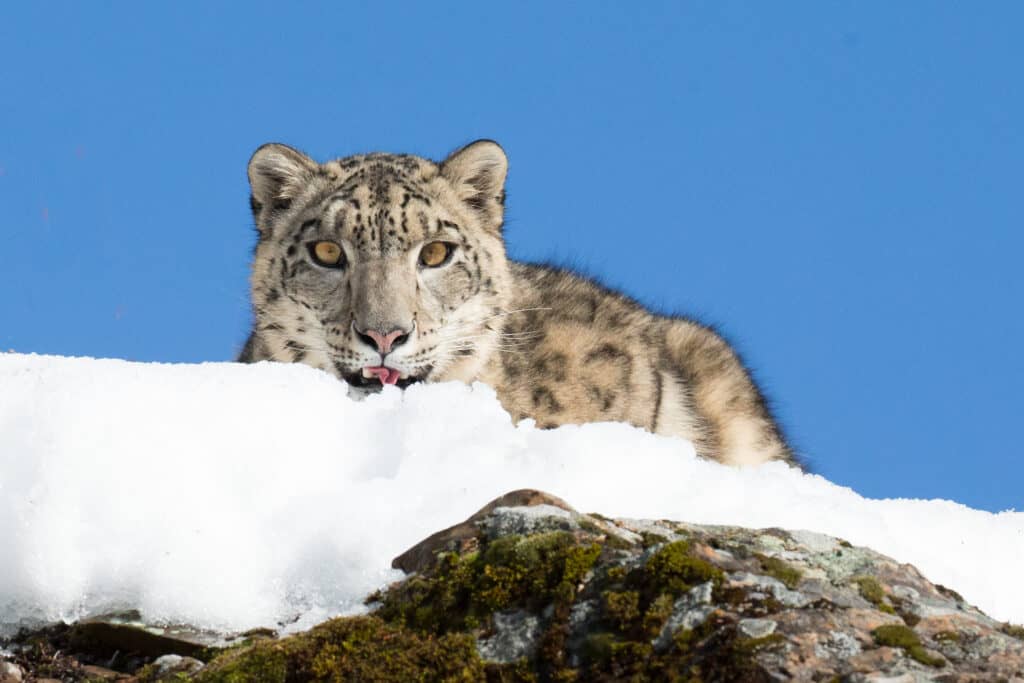
Snow leopards, martens, and birds of prey are the only natural threat to red pandas.
©Warren Metcalf/Shutterstock.com
Predators and Threats
Due to the fact that red pandas inhabit high-altitude mountain forests, they actually have fewer natural predators than if their habitat was further down the slopes. Snow leopards and martens are the only real predators of the red panda, although birds of prey and small carnivores prey on the smaller and more vulnerable cubs. The biggest threat to the red panda, however, is people who have affected this species mainly through deforestation of their incredibly unique habitats. Due to human encroachment, illegal hunting, and poaching, the panda population numbers have suffered a serious decline, with these populations also being pushed into more separate, isolated areas. One of the main concerns with this is that these populations will be threatened by inbreeding leading to less successful individuals in these areas.
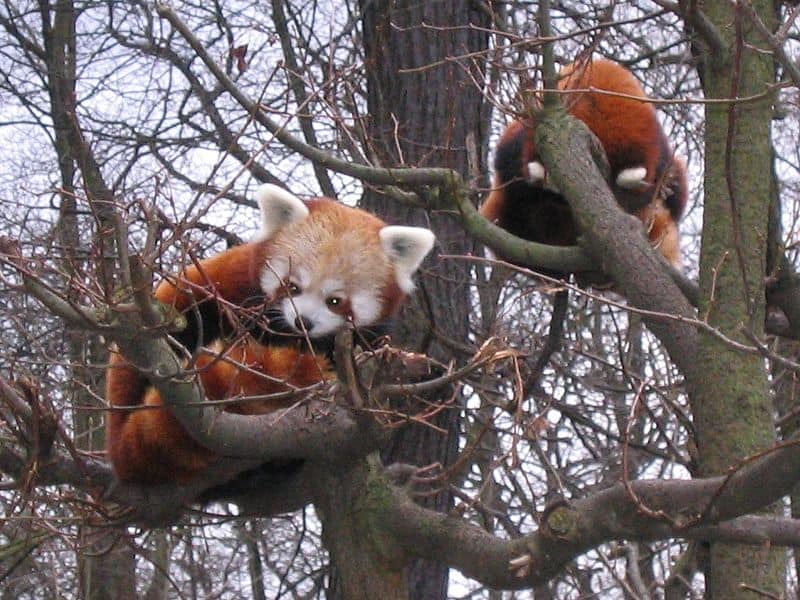
Red pandas sunbathe high in the trees to warm themselves in cold weather.
Interesting Facts and Features
Living high in cold mountain climates means that red pandas are well adapted to keeping warm, equipped with dense fur and a warm bushy tail. However, on especially cold days red pandas have been known to sunbathe high in the canopy to warm themselves up while sleeping during the day. A study conducted in 2001 found that 79% of the red pandas reported were found within 100 meters of the nearest body of water, indicating that a good water source may also be crucial to their already strict habitat requirements. Evidence also suggests that red panda reproduction rates have been declining, which is believed to be related to the decline in the foods that they eat in order to survive and reproduce successfully.
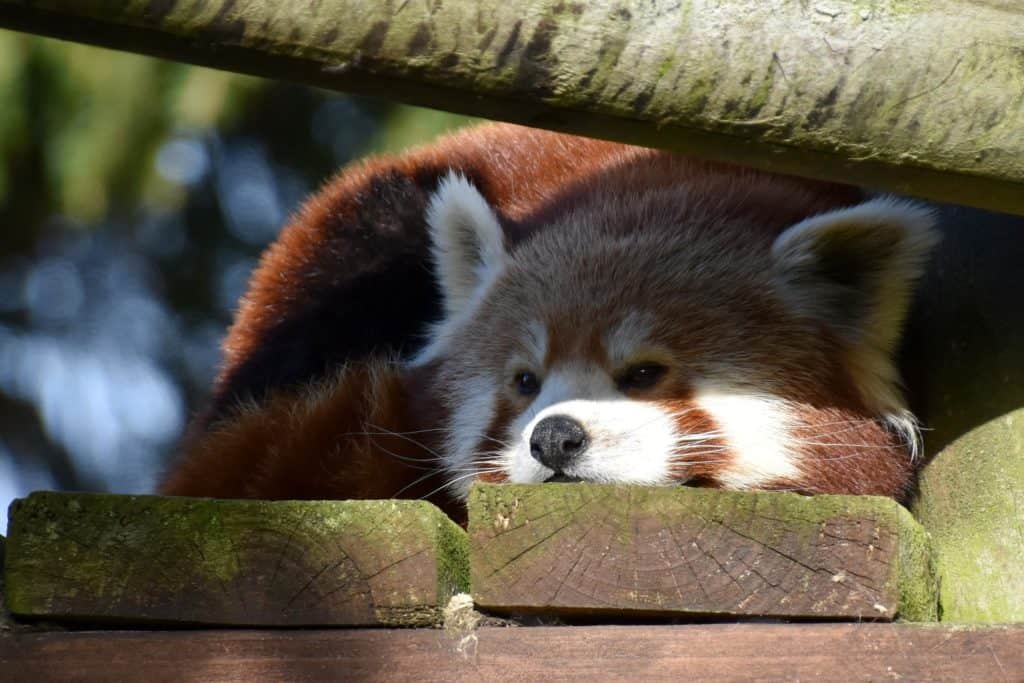
Seldom seen in the wild, red pandas can be viewed in zoos all over the world.
©Millie Bond – Copyright A-Z Animals
Relationship with Humans
Red pandas have been admired by people for years but most of the experiences that we have with them are in zoos and animal institutions These rare and secretive animals and they are incredibly difficult to spot in the wild. Our fascination with red pandas, however, is one of the factors in their demise. For example, one Indian village reported that 47 red pandas were captured and sold to zoos around the world in just one year. Human interference with their unique and specialized habitats though is believed to be the biggest reason for the decline in red panda numbers throughout the Himalayas, with deforestation mainly in the form of logging being one of the primary culprits. As with the giant panda, the red panda relies heavily on high-altitude bamboo thickets to survive and without them, unfortunately, it has nowhere else to go.
Conservation Status and Life Today
Today, the red panda is listed on the IUCN Red List as being an animal species that is Endangered in its natural environment and is therefore severely threatened by extinction in the near future. There are estimated to be less than 3,000 red pandas remaining in the wild. There are less than 10,000 red pandas in total, with the majority of these inhabiting small protected zones located in national parks. A number of captive breeding programs have also been established in Asia, Europe, and North America and appear to be having a positive impact on the red panda population.
Similar Animals…
View all 114 animals that start with RRed Panda FAQs (Frequently Asked Questions)
Do Red Pandas make good pets?
The short answer is no, red pandas do not make good pets. Not only are they endangered, but they make heavy use of scent-marking and would become stinky neighbors in any home. They are illegal to own and caring for them would be extremely difficult even if it wasn’t.
Are Red Pandas herbivores, carnivores, or omnivores?
Red Pandas are Omnivores, meaning they eat both plants and other animals.
What Kingdom do Red Pandas belong to?
Red Pandas belong to the Kingdom Animalia.
What phylum do Red Pandas belong to?
Red Pandas belong to the phylum Chordata.
What class do Red Pandas belong to?
Red Pandas belong to the class Mammalia.
What family do Red Pandas belong to?
Red Pandas belong to the family Ailuridae.
What order do Red Pandas belong to?
Red Pandas belong to the order Carnivora.
What genus do Red Pandas belong to?
Red Pandas belong to the genus Ailurus.
What type of covering do Red Pandas have?
Red Pandas are covered in Fur.
Where do Red Pandas live?
Red Pandas live in the Himalayas.
In what type of habitat do Red Pandas live?
Red Pandas live in high-altitude mountain forests.
What are some predators of Red Pandas?
Predators of Red Pandas include snow leopards, martens, and humans.
What is the average litter size for a Red Panda?
The average litter size for a Red Panda is 3.
What is an interesting fact about Red Pandas?
There are less than 3,000 Red Pandas left in the wild!
What is the scientific name for the Red Panda?
The scientific name for the Red Panda is Ailurus fulgens.
What is the lifespan of a Red Panda?
Red Pandas can live for 8 to 12 years.
What is a baby Red Panda called?
A baby Red Panda is called a cub.
How many species of Red Panda are there?
There is 1 species of Red Panda.
What is the biggest threat to the Red Panda?
The biggest threat to the Red Panda is habitat loss.
What is another name for the Red Panda?
The Red Panda is also called the lesser panda or fire fox.
How many Red Pandas are left in the world?
There are less than 3,000 Red Pandas left in the world.
How fast is a Red Panda?
A Red Panda can travel at speeds of up to 24 miles per hour.
What's the difference between a red panda and a raccoon?
Red pandas differ from raccoons in their preferred habitats and diets. Raccoons are also gray and white, while red pandas are rusty red and white in appearance.
What's the difference between a red panda and a panda?
There are many differences between pandas and red pandas. Pandas are much larger than red pandas, and red pandas have long tails, while pandas don’t. However, they have similar diets and occupy the same habitat.
How to say Red Panda in ...
Thank you for reading! Have some feedback for us? Contact the AZ Animals editorial team.
Sources
- David Burnie, Dorling Kindersley (2011) Animal, The Definitive Visual Guide To The World's Wildlife
- Tom Jackson, Lorenz Books (2007) The World Encyclopedia Of Animals
- David Burnie, Kingfisher (2011) The Kingfisher Animal Encyclopedia
- Richard Mackay, University of California Press (2009) The Atlas Of Endangered Species
- David Burnie, Dorling Kindersley (2008) Illustrated Encyclopedia Of Animals
- Dorling Kindersley (2006) Dorling Kindersley Encyclopedia Of Animals
- David W. Macdonald, Oxford University Press (2010) The Encyclopedia Of Mammals
- About Red Pandas, Available here: http://www.animalcorner.co.uk/wildlife/pandas/panda_red.html
- Red Panda Facts, Available here: http://animals.nationalgeographic.com/animals/mammals/red-panda/
- Red Panda Diet, Available here: http://www.bearlife.org/red-panda.html
- Red Panda Information, Available here: http://www.animalinfo.org/species/carnivor/ailufulg.htm
- Red Panda Conservation, Available here: http://www.iucnredlist.org/apps/redlist/details/714/0

















